Estate Jewelry: Death’s-Head Skulls and Diamond-Wing Dragonflies

Right now there’s a great exhibit, “International Art Jewelry 1895–1925,” on view at the Forbes Galleries in New York. The exhibit focuses on the emergence of “art” jewelry in the late 19th century — a time of great change, when artists and designers throughout the world were being driven by a desire to create something fresh and new (including this gorgeous morning glory pendant). Their designs often took on individual characteristics specific to their country, and the resulting styles became known by various names: Arts and Crafts, Glasgow Style, Art Nouveau, etc. A common thread runs through them all, however, and this exhibit aims to expose that commonality by gathering examples from all over the world, so that the art jewelry movement can be seen as a whole. The exhibit opened on October 29 and runs through March 17, 2012. (Image: Morning Glory Brooch/Pendant, Marcus & Co., American c. 1900. Plique-à-jour, gold. Siegelson, New York.) Definitely worth a visit.
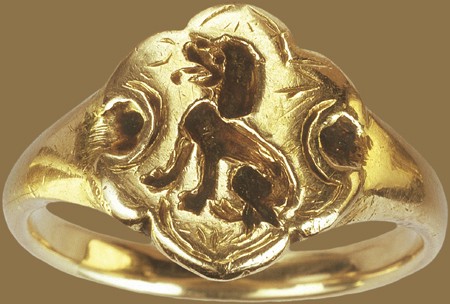
Circa 15th-century England, this gold signet ring features the Talbot, an extinct hunting dog known for its courage, vigilance, and loyalty. The Talbot was also the badge of the medieval Earls of Shrewsbury, and John Talbot, the first Earl of Shrewsbury, was a famous soldier who is sometimes referred to as the “English Achilles.” It’s thought that this ring might have belonged to Talbot or one of his family; click through to the dealer’s site to watch a short video on the ring and its origins.
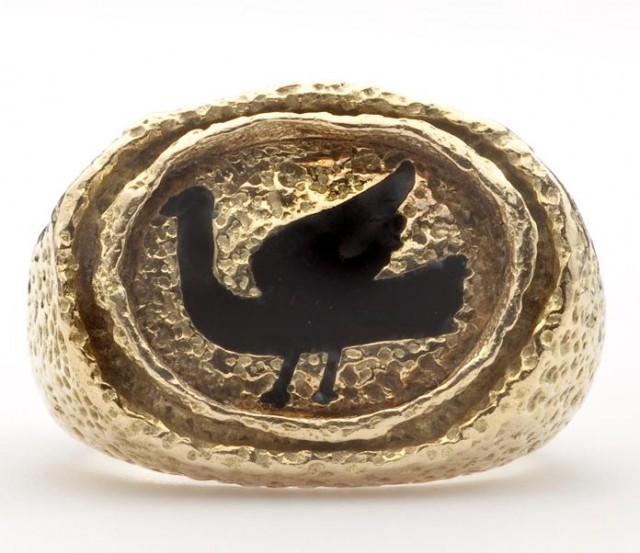
The Talbot ring reminded me of another ring, which dates to many centuries later. Circa 1961, this ring was designed by the great French artist Georges Braque. Renowned for his painting and sculpture, Braque turned to jewelry design during the last two years of his life as his health began to decline; the dealer notes that he “looked upon his jewels as little pieces of sculpture.” He often took his subjects from mythology, and this ring features the Greek mythological figure of Procris in black enamel. The ring also bears the mark of Braque’s goldsmith, Heger de Lowenfeld.
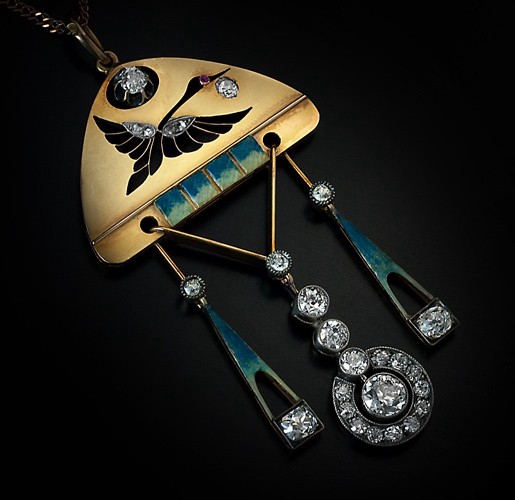
Made at Faberge’s Moscow branch between 1899 and 1908, this pendant is an example of the Neo-Russian style of the early 20th century. It features a 14k gold plaque with rounded corners and an openwork stork with rose-cut diamond accents and a ruby eye. The bottom of the plaque features sections of translucent aquamarine and gold enamel, and supports drops of diamond, gold, and enamel. The piece is hallmarked with the initials of the Moscow assay master Ivan Lebedkin, and Cyrillic initials for Karl Faberge.
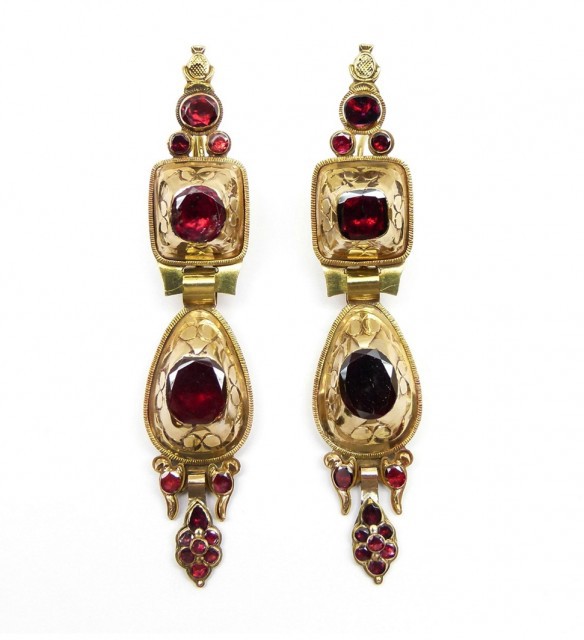
Circa 1780, these are just a beautiful pair of Iberian earrings, in gold with cushion-cut garnets, cut-away detailing to the bezels and ridged rims, and small flower-head clusters at top and bottom.

Circa 1700, this high-karat gold skeletal band ring is an example of “Memento Mori” jewelry, which dates to the 16th through the 18th centuries. It was intended to remind the wearer of his or her mortality (memento mori translates to “remember you must die”), and of the fleeting nature of time.
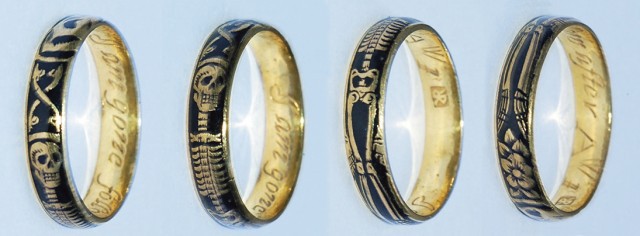
Skeletons, skulls, and coffins often figure into the designs, and here a full skeleton circles the ring. Other symbols of mortality and immortality are depicted, including a death’s-head skull, an hourglass (tempus fugit), and a flower. The interior is engraved with a posy motto: “I am gone follow after” and the initials AWI.

Sotheby’s Geneva is holding a Magnificent Jewels auction next week on November 15th, and the catalog is online. There are some incredible pieces for sale — so by all means click through and drool [Ed. — Highly recommended/unrecommended] — but I would like to point out one particular piece of interest.
This dragonfly brooch, circa 1987, features wings of carved rock crystal backed with gold and imbedded with gold-filled veins. Each wing is inset with a large triangular diamond and numerous smaller diamond accents, and the body is formed of faceted diamond roundels mounted in silver and gold. If you go to the site, you can zoom in to see the workmanship. I particularly love how the diamond roundels are of softly varying colors, to better imitate nature. Now, the maker: This piece is by JAR.
JAR is actually Joel Arthur Rosenthal, an elusive and revered figure in the contemporary jewelry world. Born in New York, Rosenthal founded JAR in Paris in 1977, and has been designing extraordinary gems out of a small, unassuming storefront on the Place Vendôme ever since. He doesn’t advertise or give interviews — and he never even had any jewelry training! — yet his designs are wildly sought after by the highest echelons of society. (They’re the only ones who can afford them; this dragonfly has a reserve price set at $250,000‐$450,000, and his pieces historically sell for above the estimate.) To learn more about JAR, check out this fantastic piece by Cathleen McCarthy for the magazine JCK (full disclosure: I once worked there, too).
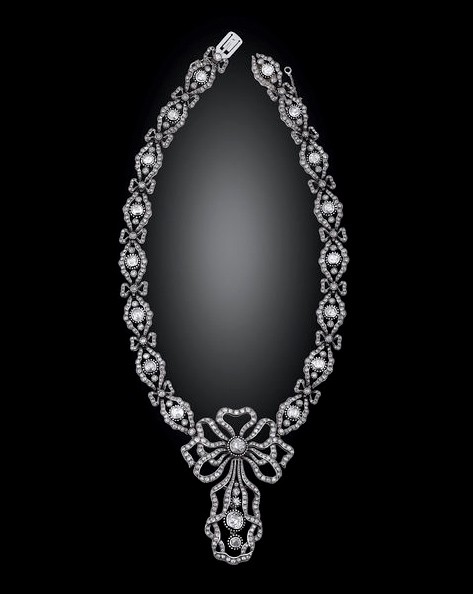
This Cartier necklace is a stunner, but it’s also rare because it dates to 1900, which is a couple decades earlier than most of the Cartier pieces that come on the market. And as you can see, the early stuff ain’t too bad: This necklace is 15.5” long, and combines ribbons of silver and gold with European-cut diamonds. It’s signed “Cartier-Paris.”
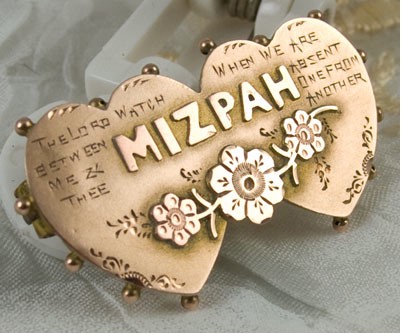
This is a sweet little example of a double heart “Mizpah” brooch in 9k rose gold. Mizpah brooches are a common example of Victorian sentimental jewelry, and they symbolize the bond between two people who are separated. The sentiment was taken from Genesis 31:49, which states “And Mizpah; for he said, The Lord watch between me and thee, when we are absent one from another.” This brooch dates to circa 1885–1905.
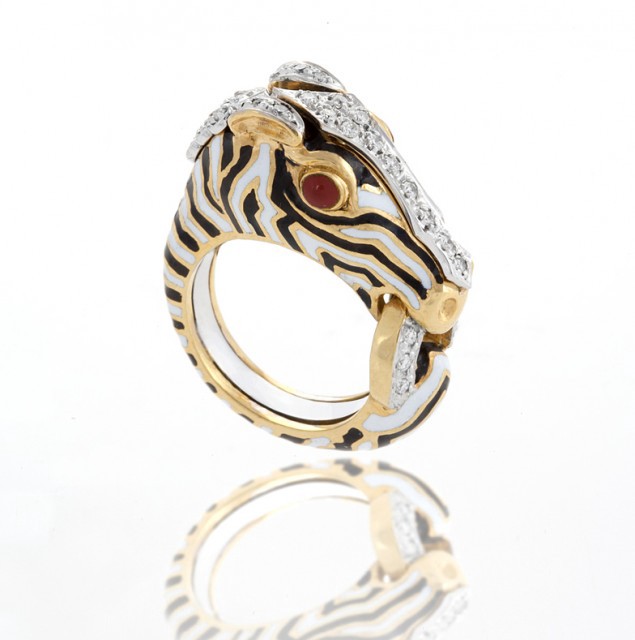
A zebra ring! This little guy is by David Webb, one of the big names in 20th-century American jewelry. Webb started his company in New York in 1948, and his bold, modern designs soon became wildly popular among socialites and movie stars alike, with fans including Jackie Kennedy, Elizabeth Taylor, Doris Duke, and Gloria Vanderbilt. Webb’s jewelry often featured natural motifs, but he’s probably most famous for his animal jewelry, which often takes the form of large cuff bracelets. (Diana Vreeland, the iconic former editor of Harper’s Bazaar and Vogue, often wore a black and white enamel zebra cuff that was similar to this ring.)
Webb died in 1975, but his business partner and her family kept the company going for another 35 years until they finally sold the business in 2010. The new owners plan to continue using the Webb archives to carry on the tradition.
This ring dates to the 1970s, and features 18k gold with black and white enameling and 29 round-cut diamonds. The eyes are red enamel.
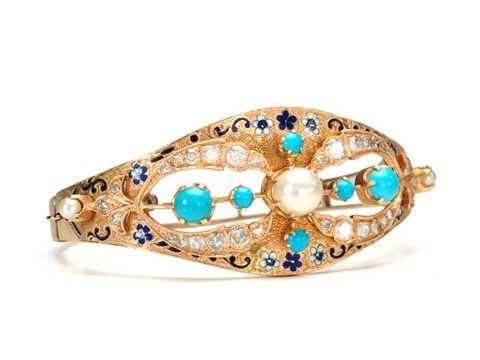
This European openwork bangle bracelet could be a revival of a revival — it dates to around 1940, but it’s reminiscent of the Renaissance-revival jewelry of the late 1800s. It’s made of 18k rose gold, pearls, turquoise, and diamonds, and features delicate floral-motif enameling in blue and white. Lovely.
Previously: Liz’s Diamonds and Victorian Brooch Jokes.
Monica McLaughlin wants those Iberian garnet earrings so badly she can TASTE them.